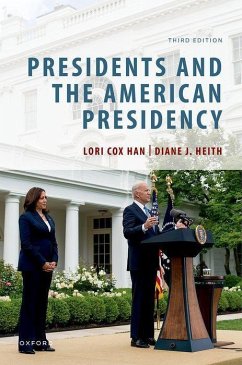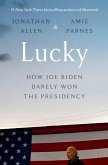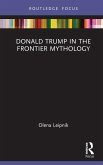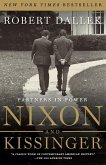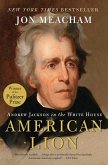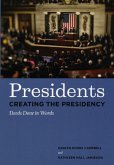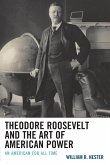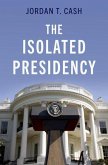Lori Cox Han (Professor of Politica Professor of Political Science, Diane Heith (Professor of Government and Professor of Gov Politics
Presidents and the American Presidency
Lori Cox Han (Professor of Politica Professor of Political Science, Diane Heith (Professor of Government and Professor of Gov Politics
Presidents and the American Presidency
- Broschiertes Buch
Andere Kunden interessierten sich auch für
![Lucky: How Joe Biden Barely Won the Presidency Lucky: How Joe Biden Barely Won the Presidency]() Jonathan AllenLucky: How Joe Biden Barely Won the Presidency27,99 €
Jonathan AllenLucky: How Joe Biden Barely Won the Presidency27,99 €![Donald Trump in the Frontier Mythology Donald Trump in the Frontier Mythology]() Olena LeipnikDonald Trump in the Frontier Mythology55,99 €
Olena LeipnikDonald Trump in the Frontier Mythology55,99 €![Nixon and Kissinger Nixon and Kissinger]() Robert DallekNixon and Kissinger22,99 €
Robert DallekNixon and Kissinger22,99 €![American Lion American Lion]() Jon MeachamAmerican Lion23,99 €
Jon MeachamAmerican Lion23,99 €![Presidents Creating the Presidency Presidents Creating the Presidency]() Karlyn Kohrs CampbellPresidents Creating the Presidency41,99 €
Karlyn Kohrs CampbellPresidents Creating the Presidency41,99 €![Theodore Roosevelt and the Art of American Power Theodore Roosevelt and the Art of American Power]() William R. NesterTheodore Roosevelt and the Art of American Power31,99 €
William R. NesterTheodore Roosevelt and the Art of American Power31,99 €![The Isolated Presidency The Isolated Presidency]() Jordan T. Cash (Assistant Professor, James Madison College, AssistaThe Isolated Presidency69,99 €
Jordan T. Cash (Assistant Professor, James Madison College, AssistaThe Isolated Presidency69,99 €-
-
-
Produktdetails
- Verlag: Oxford University Press Inc
- 3 Revised edition
- Seitenzahl: 558
- Erscheinungstermin: 22. August 2023
- Englisch
- Abmessung: 154mm x 234mm x 35mm
- Gewicht: 828g
- ISBN-13: 9780197643457
- ISBN-10: 0197643450
- Artikelnr.: 63459534
Hinweis: Dieser Artikel kann nur an eine deutsche Lieferadresse ausgeliefert werden.
- Herstellerkennzeichnung
- Libri GmbH
- Europaallee 1
- 36244 Bad Hersfeld
- gpsr@libri.de
Lori Cox-Han is Professor of Political Science and Doy B. Henley Endowed Chair in American Presidential Studies.Her research and teaching expertise include the presidency, women and politics, media and politics, and political leadership. Diane J. Heith is Professor of Government and Politics. She is the author of several works on the presidency, public opinion, campaigns and elections, and the media.
BRIEF CONTENTS
Preface
Tables and figures
Chapter 1 Introduction: Studying Presidents and the Presidency
Chapter 2 Presidents and the Constitution
Chapter 3 The Presidential Selection Process
Chapter 4 The Public Presidency: Communication and Mass Media
Chapter 5 The Public Presidency: Public Opinion
Chapter 6 Presidents and the Legislative Branch
Chapter 7 Presidents and the Judicial Branch
Chapter 8 Presidents and the Executive Branch
Chapter 9 Presidents and Domestic/ Economic Policy
Chapter 10 Presidents and Foreign Policy
Appendix A Conducting Research at Presidential Libraries
Appendix B Presidential Election Results, 1789-2020
NOTES
SELECTED BIBLIOGRAPHY
CREDITS
INDEX
CONTENTS
PREFACE
TABLES AND FIGURES
Chapter 1 Introduction: Studying Presidents and the Presidency
Historical Context
Theories and Methodologies
Sources for Researching the Presidency
Conclusion
Chapter 2 Presidents and the Constitution
The Framers' Plan and the Constitutional Convention
Powers of the Office
Expansion of Presidential Powers
Conclusion
Chapter 3 The Presidential Selection Process
The Nominating Process in Historical Perspective
The Pre-Nomination Period
Primaries and Caucuses
Financing Presidential Campaigns
National Party Conventions
The General Election
The Consequences of Winning
Conclusion
Chapter 4 The Public Presidency: Communication and Mass Media
The Evolving Rhetorical Presidency
Presidential Communication: Strategies and Resources
The President and the Press
Conclusion
Chapter 5 The Public Presidency: Public Opinion
The Evolving View of the Public
Evaluating the President
Popularity as a Source of Presidential Power
Presidential Polling as a Source of Power
Other Ways to Gather Opinion
Conclusion
Chapter 6 Presidents and the Legislative Branch
The President's Formal Role in the Legislative Process
Creating the Chief Legislator
Achieving Legislative Success
The Challenges of Sharing Powers
Conclusion
Chapter 7 Presidents and the Judicial Branch
Nominations to the U.S. Supreme Court
Nominations to Lower Federal Courts
The President's Relationship with the Judicial Branch
Conclusion
Chapter 8 Presidents and the Executive Branch
The Job of the Chief Executive
The Executive Office of the President
Presidential Control of the Bureaucracy
Vice Presidents
First Ladies
Conclusion
Chapter 9 Presidents and Domestic/Economic Policy
The Political Environment
Domestic and Economic Policymaking
Actors in the Policymaking Process
Economic Policy
Domestic Policy
Health Care: A Case Study
Conclusion
Chapter 10 Presidents and Foreign Policy
Foreign Policy Defined
Presidents and Foreign Policymaking
The Evolution of U.S. Foreign Policy
Implementing the Foreign-Policy Agenda
Conclusion
Appendix A Conducting Research at Presidential Libraries
Appendix B Presidential Election Results, 1789-2020
NOTES
SELECTED BIBLIOGRAPHY
CREDITS
INDEX
Preface
Tables and figures
Chapter 1 Introduction: Studying Presidents and the Presidency
Chapter 2 Presidents and the Constitution
Chapter 3 The Presidential Selection Process
Chapter 4 The Public Presidency: Communication and Mass Media
Chapter 5 The Public Presidency: Public Opinion
Chapter 6 Presidents and the Legislative Branch
Chapter 7 Presidents and the Judicial Branch
Chapter 8 Presidents and the Executive Branch
Chapter 9 Presidents and Domestic/ Economic Policy
Chapter 10 Presidents and Foreign Policy
Appendix A Conducting Research at Presidential Libraries
Appendix B Presidential Election Results, 1789-2020
NOTES
SELECTED BIBLIOGRAPHY
CREDITS
INDEX
CONTENTS
PREFACE
TABLES AND FIGURES
Chapter 1 Introduction: Studying Presidents and the Presidency
Historical Context
Theories and Methodologies
Sources for Researching the Presidency
Conclusion
Chapter 2 Presidents and the Constitution
The Framers' Plan and the Constitutional Convention
Powers of the Office
Expansion of Presidential Powers
Conclusion
Chapter 3 The Presidential Selection Process
The Nominating Process in Historical Perspective
The Pre-Nomination Period
Primaries and Caucuses
Financing Presidential Campaigns
National Party Conventions
The General Election
The Consequences of Winning
Conclusion
Chapter 4 The Public Presidency: Communication and Mass Media
The Evolving Rhetorical Presidency
Presidential Communication: Strategies and Resources
The President and the Press
Conclusion
Chapter 5 The Public Presidency: Public Opinion
The Evolving View of the Public
Evaluating the President
Popularity as a Source of Presidential Power
Presidential Polling as a Source of Power
Other Ways to Gather Opinion
Conclusion
Chapter 6 Presidents and the Legislative Branch
The President's Formal Role in the Legislative Process
Creating the Chief Legislator
Achieving Legislative Success
The Challenges of Sharing Powers
Conclusion
Chapter 7 Presidents and the Judicial Branch
Nominations to the U.S. Supreme Court
Nominations to Lower Federal Courts
The President's Relationship with the Judicial Branch
Conclusion
Chapter 8 Presidents and the Executive Branch
The Job of the Chief Executive
The Executive Office of the President
Presidential Control of the Bureaucracy
Vice Presidents
First Ladies
Conclusion
Chapter 9 Presidents and Domestic/Economic Policy
The Political Environment
Domestic and Economic Policymaking
Actors in the Policymaking Process
Economic Policy
Domestic Policy
Health Care: A Case Study
Conclusion
Chapter 10 Presidents and Foreign Policy
Foreign Policy Defined
Presidents and Foreign Policymaking
The Evolution of U.S. Foreign Policy
Implementing the Foreign-Policy Agenda
Conclusion
Appendix A Conducting Research at Presidential Libraries
Appendix B Presidential Election Results, 1789-2020
NOTES
SELECTED BIBLIOGRAPHY
CREDITS
INDEX
BRIEF CONTENTS
Preface
Tables and figures
Chapter 1 Introduction: Studying Presidents and the Presidency
Chapter 2 Presidents and the Constitution
Chapter 3 The Presidential Selection Process
Chapter 4 The Public Presidency: Communication and Mass Media
Chapter 5 The Public Presidency: Public Opinion
Chapter 6 Presidents and the Legislative Branch
Chapter 7 Presidents and the Judicial Branch
Chapter 8 Presidents and the Executive Branch
Chapter 9 Presidents and Domestic/ Economic Policy
Chapter 10 Presidents and Foreign Policy
Appendix A Conducting Research at Presidential Libraries
Appendix B Presidential Election Results, 1789-2020
NOTES
SELECTED BIBLIOGRAPHY
CREDITS
INDEX
CONTENTS
PREFACE
TABLES AND FIGURES
Chapter 1 Introduction: Studying Presidents and the Presidency
Historical Context
Theories and Methodologies
Sources for Researching the Presidency
Conclusion
Chapter 2 Presidents and the Constitution
The Framers' Plan and the Constitutional Convention
Powers of the Office
Expansion of Presidential Powers
Conclusion
Chapter 3 The Presidential Selection Process
The Nominating Process in Historical Perspective
The Pre-Nomination Period
Primaries and Caucuses
Financing Presidential Campaigns
National Party Conventions
The General Election
The Consequences of Winning
Conclusion
Chapter 4 The Public Presidency: Communication and Mass Media
The Evolving Rhetorical Presidency
Presidential Communication: Strategies and Resources
The President and the Press
Conclusion
Chapter 5 The Public Presidency: Public Opinion
The Evolving View of the Public
Evaluating the President
Popularity as a Source of Presidential Power
Presidential Polling as a Source of Power
Other Ways to Gather Opinion
Conclusion
Chapter 6 Presidents and the Legislative Branch
The President's Formal Role in the Legislative Process
Creating the Chief Legislator
Achieving Legislative Success
The Challenges of Sharing Powers
Conclusion
Chapter 7 Presidents and the Judicial Branch
Nominations to the U.S. Supreme Court
Nominations to Lower Federal Courts
The President's Relationship with the Judicial Branch
Conclusion
Chapter 8 Presidents and the Executive Branch
The Job of the Chief Executive
The Executive Office of the President
Presidential Control of the Bureaucracy
Vice Presidents
First Ladies
Conclusion
Chapter 9 Presidents and Domestic/Economic Policy
The Political Environment
Domestic and Economic Policymaking
Actors in the Policymaking Process
Economic Policy
Domestic Policy
Health Care: A Case Study
Conclusion
Chapter 10 Presidents and Foreign Policy
Foreign Policy Defined
Presidents and Foreign Policymaking
The Evolution of U.S. Foreign Policy
Implementing the Foreign-Policy Agenda
Conclusion
Appendix A Conducting Research at Presidential Libraries
Appendix B Presidential Election Results, 1789-2020
NOTES
SELECTED BIBLIOGRAPHY
CREDITS
INDEX
Preface
Tables and figures
Chapter 1 Introduction: Studying Presidents and the Presidency
Chapter 2 Presidents and the Constitution
Chapter 3 The Presidential Selection Process
Chapter 4 The Public Presidency: Communication and Mass Media
Chapter 5 The Public Presidency: Public Opinion
Chapter 6 Presidents and the Legislative Branch
Chapter 7 Presidents and the Judicial Branch
Chapter 8 Presidents and the Executive Branch
Chapter 9 Presidents and Domestic/ Economic Policy
Chapter 10 Presidents and Foreign Policy
Appendix A Conducting Research at Presidential Libraries
Appendix B Presidential Election Results, 1789-2020
NOTES
SELECTED BIBLIOGRAPHY
CREDITS
INDEX
CONTENTS
PREFACE
TABLES AND FIGURES
Chapter 1 Introduction: Studying Presidents and the Presidency
Historical Context
Theories and Methodologies
Sources for Researching the Presidency
Conclusion
Chapter 2 Presidents and the Constitution
The Framers' Plan and the Constitutional Convention
Powers of the Office
Expansion of Presidential Powers
Conclusion
Chapter 3 The Presidential Selection Process
The Nominating Process in Historical Perspective
The Pre-Nomination Period
Primaries and Caucuses
Financing Presidential Campaigns
National Party Conventions
The General Election
The Consequences of Winning
Conclusion
Chapter 4 The Public Presidency: Communication and Mass Media
The Evolving Rhetorical Presidency
Presidential Communication: Strategies and Resources
The President and the Press
Conclusion
Chapter 5 The Public Presidency: Public Opinion
The Evolving View of the Public
Evaluating the President
Popularity as a Source of Presidential Power
Presidential Polling as a Source of Power
Other Ways to Gather Opinion
Conclusion
Chapter 6 Presidents and the Legislative Branch
The President's Formal Role in the Legislative Process
Creating the Chief Legislator
Achieving Legislative Success
The Challenges of Sharing Powers
Conclusion
Chapter 7 Presidents and the Judicial Branch
Nominations to the U.S. Supreme Court
Nominations to Lower Federal Courts
The President's Relationship with the Judicial Branch
Conclusion
Chapter 8 Presidents and the Executive Branch
The Job of the Chief Executive
The Executive Office of the President
Presidential Control of the Bureaucracy
Vice Presidents
First Ladies
Conclusion
Chapter 9 Presidents and Domestic/Economic Policy
The Political Environment
Domestic and Economic Policymaking
Actors in the Policymaking Process
Economic Policy
Domestic Policy
Health Care: A Case Study
Conclusion
Chapter 10 Presidents and Foreign Policy
Foreign Policy Defined
Presidents and Foreign Policymaking
The Evolution of U.S. Foreign Policy
Implementing the Foreign-Policy Agenda
Conclusion
Appendix A Conducting Research at Presidential Libraries
Appendix B Presidential Election Results, 1789-2020
NOTES
SELECTED BIBLIOGRAPHY
CREDITS
INDEX

